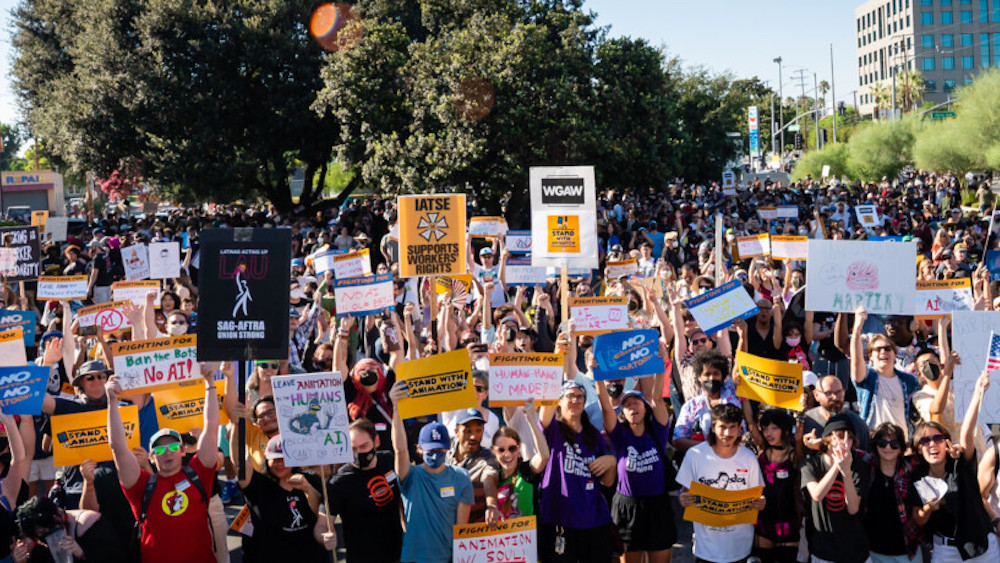The Animation Guild is back at the table with the studios this week, hoping to seal the deal on a new contract by Friday.
Last month, the union said it was still “far apart” from the studios on several key issues, prompting a second scheduled week of negotiations to hammer out the details. The negotiating committee voted to extend the contract until September 20 and, as the clock ticks, some in the animation community have taken matters into their own hands to raise awareness on the key issues plaguing these creatives.
“It’s really difficult, and it’s especially painful, because the animation industry was the only thing functioning in Hollywood during the lockdown. So whatever money they were making, they [were] making it from our labor,” Gene Goldstein, president of Jellybox Studio, told Deadline. “Then it seems like, as soon as there was a hint of a recession…the industry as a whole has been kind of kicked to the curb.”
Goldstein has helped shepherd a series of animated shorts highlighting the threats to animation in hopes of reaching the broader Hollywood labor community — and beyond — for support. Jellybox began publishing the shorts in May, beginning with an explainer titled “Animation in under attack!”
The 46-second video provides a rundown of the most pressing issues in animation, calling attention to the fact that last year’s historically long WGA and SAG-AFTRA strikes were actually only a fraction of Hollywood labor’s fight with the major studios.
The series of four shorts, written by Sean Aitchison with Adam Conover voicing the host, is not officially affiliated with the Animation Guild. But, they do break down some of the priorities that the guild and its negotiating committee are hoping to address at the bargaining table, including artificial intelligence and staffing.
AI poses an obvious threat to both animators and writers who tell Deadline they are already suffering from a lack of jobs due to the massive production contraction that has impacted nearly all Hollywood workers, as well as the elimination of staff positions, which has made getting (and keeping) a steady gig nearly impossible.
As one veteran animation writer explained of their own situation: “In 2021, all that year, I was staffed on a show, and in 2022, all that year, I did freelance. I wrote 19 scripts for seven different shows. I made 33% less in 2022…the math isn’t mathing.”
This writer adds that, while writers rooms have been dwindling for some time, there’s been a “great increase” in the elimination of staff positions over last few years in favor of staffing a head writer and hiring freelancers to craft each script. Deadline understands that the Animation Guild is seeking staffing minimums, similar to those that the WGA secured in its own contract, to help curb the issue.
Not only does eliminating staff positions create a financially unstable environment, it also shuts up-and-coming writers out of the workforce almost entirely.
“It’s a real barrier, especially to anybody who doesn’t come from a privileged background,” the veteran writer said. “Basically, if you don’t have a cushion, it becomes, frankly, a hobby, which is not what we want. It’s not good for the industry. It’s not good for the shows. It’s not good for the writers. It’s not good for [anyone].”
That problem is expected to be, and in some ways already is, exacerbated by generative AI tools, which threaten to replace many entry level positions.
The Hollywood labor community has been sounding the alarm on AI for more than two years, and the conversation reached a fever pitch last year, when both strikes hinged on the guilds securing AI protections, among other provisions. But, despite the fact that some unions have already managed to address AI with the major studios, some are still struggling. SAG-AFTRA is currently on strike again, this time against the major video game developers, due to the same issue.
Generative AI isn’t sophisticated enough just yet to replace all human creatives, and it will be a long while before that happens (if it ever does), but especially in animation, workers say that it can already perform some of the basic tasks that were once included in entry level positions. As those disappear, workers worry it will begin to erase the pipeline for work altogether.
“You can’t have an entry level position that requires 10 years of experience, and you’re basically an art director already. Especially as an artist, [but] even in production, you have to know everything about the pipeline and be able to manage it on your own,” a TAG member and production worker told Deadline.
They, like many, called moved to transition toward AI “short-sighted,” and explained that TAG is taking what they’re dubbing a “multi-pronged” approach to combatting the use of the technology to replace workers.
In addition to pushing for contract provisions, they are joining other Hollywood unions in lobbying at the state and federal level for AI-related legislation as well. There are several AI bills circulating in Washington, D.C., and more in California, including some that have already been sent to the Governor’s desk.
“Even these softwares, they can’t do it on their own. They need someone with knowledge and the skills to be able to do this. If these companies push us out…maybe it’ll work for a couple of years, but then you’ll just have a beige bag of mush, because it’ll all just be regurgitating the same exact thing. That’s all they have. They don’t have any creativity,” the production worker continued.
Jellybox has a short for this, too. The most recent video in its series, released in July, encourages animation lovers to “support human art” to prevent the medium from becoming an “AI hellscape.”
“By its very nature, technology is meant to rid us of putting us in dangerous positions, putting us in places where we are overworking ourselves,” Aitchison said. “It’s meant to give us more time to make art, not take away our ability to.”

